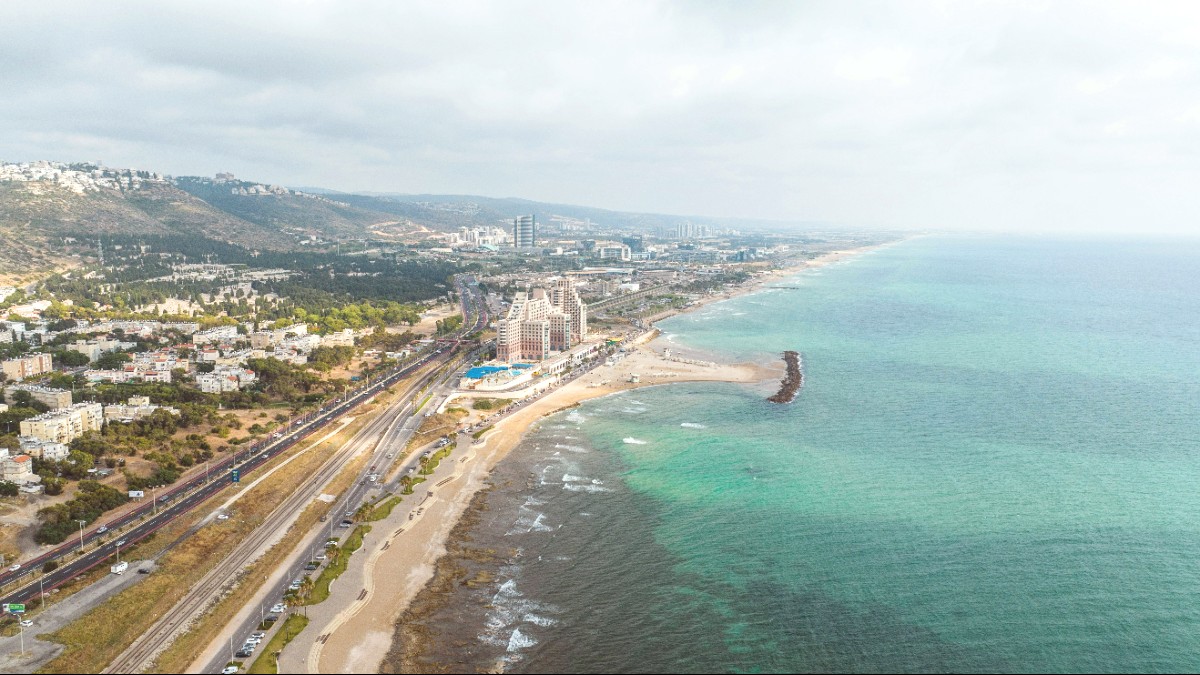
Mediterranean Coast, Israel And The Palestinian Territories
Haifa occupies a dramatic and picturesque setting on Israel's Mediterranean coast. Its most prominent geographical feature is Mount Carmel, a ridge stretching southeast from the city center. The city ascends these slopes in a series of natural terraces, giving many neighborhoods stunning views of Haifa Bay and the vast expanse of the Mediterranean Sea. This terraced layout defines the city's structure, with a lower city at sea level, including the port and downtown areas, and an upper city, Carmel Center, atop the mountain. The steep ascent and descent between these levels shape the scenery and transportation like the Carmelit funicular and the Haifa Cable Car.
Haifa Bay, a natural deep-water harbor, defines the city's coastal edge. This bay protects the port, making it Israel's largest and most important. The city's beaches, like Bat Galim and Dado, stretch along this bay, with sandy shores and clear waters. Beyond the urban core, Mount Carmel National Park provides a natural backdrop, with hiking trails, diverse flora, and a refuge from the urban environment.
The city's position makes it a gateway to northern Israel. From Haifa, access to the Galilee region, with its biblical sites and lush landscapes, is straightforward. The coastal plain stretches south, connecting Haifa to Tel Aviv and central Israel. This strategic location, both geographically and economically, supports Haifa's role as a major urban center and a gateway for regional exploration.
Haifa's history spans thousands of years, mirroring the civilizations across the Levant. Archeological findings indicate human settlement dating back to the Stone Age. Over centuries, various empires and cultures claimed this strategic port city. During the Roman and Byzantine periods, Haifa was a smaller settlement, overshadowed by nearby Caesarea Maritima. Its natural harbor consistently held strategic worth.
The early 20th century, under British Mandate rule, saw Haifa grow as a major port and industrial city. The British built modern port facilities, expanded the railway network, and developed oil refineries, transforming Haifa into the economic powerhouse of northern Palestine. This era brought Jewish immigrants, who greatly added to the city's growth and diversified its population. The Technion – Israel Institute of Technology, and the University of Haifa were established, solidifying the city's role as a center for education and innovation.
Fortified and used for its port.
Grew as a commercial hub from the 18th century.
Mid-19th century, influenced architecture and urban planning.
Became the global spiritual and administrative heart of the Baha'i world.
Early 20th century, transformed into an economic powerhouse.
After the establishment of the State of Israel in 1948, Haifa continued as a main port and industrial center. Its diverse population, including significant Jewish, Arab, and Druze communities, continued to live together, often seen as a model of coexistence in the region. This history of diverse communities living and working together shaped Haifa into an uniquely multicultural urban landscape.
The German Templers' well-built stone houses, often with red-tiled roofs, characterize what is now the German Colony, a popular tourist area. The city's historical layers show everywhere, from ancient ruins to Ottoman-era buildings, Templar homes, and modern high-rises.
The Baha'i presence added to the city's reputation for tolerance and coexistence. Synagogues, mosques, churches, and the Baha'i Shrine stand in close proximity, a symbol of a shared urban identity.
The unique topography influences urban planning and daily life. Architects and engineers built the city in harmony with its natural slopes, creating a cityscape that unfolds with each turn. The views from Mount Carmel are a constant reminder of Haifa's connection to the sea and its vast surroundings.
Haifa today a lively experience, combining its historical depth with a forward-looking perspective. Travelers often identify Haifa by its most striking feature: the Baha'i Gardens. These terraces are not just a garden; they are a spiritual and architectural marvel. They draw visitors from around the world to witness their beauty and learn about the Baha'i Faith.
Below the gardens lies the German Colony, a neighborhood with restored Templer buildings. These buildings now house restaurants and cafes, making it a popular spot for dining and evening strolls. The street offers a direct line of sight up to the illuminated Baha'i Shrine at night, a view that captures the city's unique charm.
Mount Carmel National Park offers numerous hiking trails. The city's beaches provide opportunities for swimming and relaxation.
The city hosts museums, including Madatech (Science Museum) and the Tikotin Museum of Japanese Art.
Jewish, Arab, Druze, and Baha'i communities live and work together. The "Holiday of Holidays" festival represents this shared spirit.
In essence, Haifa provides a complete travel experience. It includes spiritual reflection at its holy sites, intellectual engagement at its museums and universities, culinary exploration in its diverse neighborhoods, and outdoor adventure on its mountain slopes and beaches.
Plan your visit to Haifa carefully. Consider staying in different neighborhoods to experience the city's diverse character. For example, choose the German Colony for dining and easy access to the Baha'i Gardens, or the Carmel Center for views and luxury, or Downtown for budget-friendly options and local charm. Public transport connects these distinct areas.
Haifa's unique layered geography means Comfortable shoes help explore the many inclines and stairs.